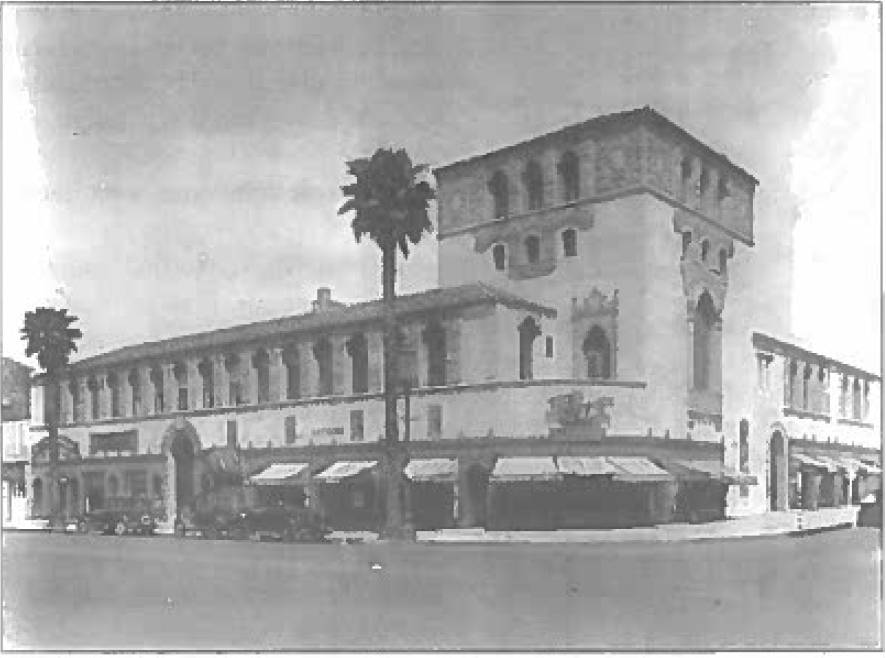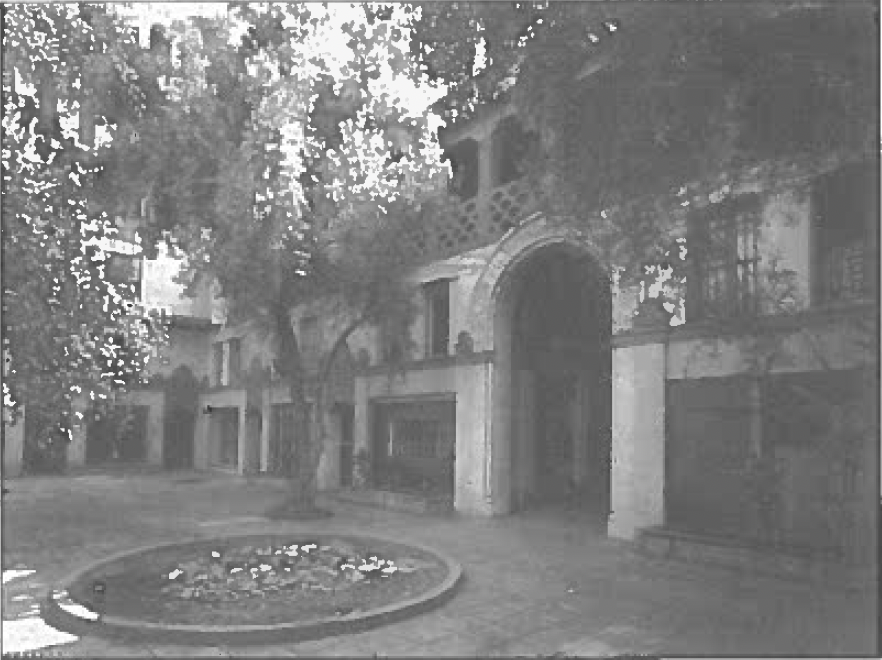The historic McKinley Building at Wilshire Boulevard and Oxford Street has survived major earthquakes, economic woes, and the vagaries of Metro construction. But it might not survive its owner's push for City approval to raze it and build a parking lot. As the City Council weighs certification of an embattled demolition EIR against granting the building protected status, TPR is pleased to present the following plea from Los Angeles Conservancy Executive Director Linda Dishman.

“Built in 1927, the McKinley Building is a Spanish Colonial Revival structure with a central courtyard, a three-story corner tower and ornate decorative details… So, before the McKinley Building is destroyed, we have to ask the question: ‘Why?’”
When a historic building is demolished, the public asks why. Why wasn’t there someone who would buy and preserve it? Why wasn't there a City plan to prevent the demolition? Why wasn't there funding available? With increasing awareness of rehabilitation and adaptive use projects around the country, the public is demanding answers to these kinds of questions before allowing the destruction of historic buildings. This is especially true when a building is being razed for a parking lot. It raises questions about community priorities, the goals of city planning, and the rights of private property owners.
For almost two years, the historic McKinley Building in the Wilshire Center/Koreatown Redevelopment Area has been threatened with demolition to make way for a surface parking lot at the northeast corner of Wilshire Boulevard and Oxford Avenue, across the street from the Willem Theatre. Built in 1927, the McKinley Building is a Spanish Colonial Revival structure with a central courtyard, a three-story corner tower and ornate decorative details. The building was designed by Morgan Walls and Clements—one of Los Angeles' most prestigious architectural firms—who created such landmarks as the Wiltern Theatre, the Chapman Market on Sixth Street, and several theaters, including the El Capitan, the Pantages, and the Mayan.
So, before the McKinley Building is destroyed, we must ask the question: "Why?"
The owner claims that the building is structurally unsound due to damage from the Northridge Earthquake and subway construction, and that it would be economically infeasible to repair. He maintains that leveling the structure for a parking lot is the only way he can produce a return on his investment. However, he began the campaign to demolish the building in January 1995—one year after the Northridge earthquake—when he had a motion introduced in City Council to declare the building an imminent hazard. It seemed this "new" discovery of a hazardous condition was just an attempt to cut through red tape to obtain a demolition permit.
After testimony from City engineers that the McKinley Building was not severely damaged, the Council voted to require an environmental impact report (EIR) because the building has official historic designation. The Council subsequently instructed the Department of Building & Safety not to issue any demolition permit until the EIR was complete and had been submitted to the Council for review and consideration.
After the City acted, the Los Angeles Conservancy asked the owner if he would consider selling the landmark building. When he replied that he would, we proceeded to find buyers. Yet, the owner and his representatives would not speak to the several developers we identified who were interested in purchasing and rehabilitating the McKinley Building.
And it is not just private developers who are interested in the McKinley Building. A parking lot adjacent to the newly opened Metro Rail station at Wilshire and Western is contrary to the Metropolitan Transportation Authority's goal of encouraging development at the stations. The proposed parking lot would undermine attempts to upgrade the area now that the subway construction is complete. It also would negate years of multi-agency planning efforts to revitalize the Wilshire Corridor. The Redevelopment Plan Area goals include preservation of historic buildings.
The Community Redevelopment Agency also questions the impact a large corner parking lot would have on the area's revitalization efforts. Working in early 1997 with the MTA and the Los Angeles Department of Transportation, the CRA proposed the Wilshire and Western Transit Center for the block. This proposal would create an efficient intermodal transit center and bring greater joint development opportunities because the site includes vacant parcels owned by the public agencies. A key element is the CRA's acquisition of the McKinley Building, which would be rehabilitated with private development funds to serve as the cornerstone of the project, which might include larger, future development.
The Transit Center proposal has broad-based support from the MTA, the L.A. DOT, the Community Advisory Committee of the Wilshire Center and Koreatown Redevelopment Area, the Korean American Coalition, the Korean American Chamber of Commerce of Los Angeles, the Los Angeles City Historical Society, the City of Los Angeles Cultural Affairs Department, the Los Angeles Conservancy, and the State Office of Historic Preservation. This past June, the MTA demonstrated its strong support by granting $3.2 million to the City of Los Angeles for the project.
Yet, despite the wide range of public and private support to save the McKinley Building, its owner persists in pursuing demolition. In September, the Department of Building & Safety certified the EIR and began processing a demolition permit. The Conservancy immediately appealed the EIR certification to the Board of Building & Safety Commissioners and asked the City Council to review the issue. The Board subsequently upheld the EIR certification despite overwhelming evidence in the department's files contradicting the EIR's findings about the condition of the building and the rehabilitation costs.
According to the owner funded EIR, it would cost over $7.6 million to rehabilitate the 40,000 s.f. structure. Yet Building & Safety's own files containing numerous inspection reports and the EIR analysis by its engineers state:
- The building is "repairable."
- The seismic/Metro Rail damage was "minor to moderate."
- The owner "wants the building red tagged and plans to demolish, not repair it."
- The building "should be green tagged."
- The EIR's rehabilitation costs are "grossly exaggerated," placing seismic rehabilitation cost at $52.50 a square foot, while the average seismic rehabilitation (Division 88) cost documented by Building & Safety ranges from $6 to $13 per square foot.
- The EIR estimates are "significantly higher than the department's historical and current data."
Because of the contradictions among the EIR certification, the Building & Safety files and the available funding for purchase, the Conservancy asked Councilmember Laura Chick to sponsor a motion for Council to consider the findings of the EIR and the Historic-Cultural Monument designation of the McKinley Building. It was seconded by Councilmembers Hal Bernson and Joel Wachs. Even though the building is in the 10th Council District and Councilmember Nate Holden is supporting demolition, the motion was referred to the Arts, Health & Humanities Committee.
At the hearing the Chair, Councilmember Michael Feuer, directed the parties to return with additional information. He asked the CRA to work out the details of a development agreement for the Transit Center, the Conservancy to have the interested buyers develop proposals further, and the owner not to be so intransigent about offers to buy the building.
Clearly, the McKinley Building does not have to be demolished. The owner has many alternatives to razing the historic landmark. For example, he could be part of a joint development. He could sell just the building while retaining the greater portion of the property for future development. Or he could sell the property under the threat of condemnation, which would provide favorable tax advantages.
The future of the McKinley Building remains in doubt. We are asking the right questions now so that the public does not have to wonder why another historic building was destroyed. There are funds available to acquire the McKinley Building, developers to rehabilitate it, and a City plan for the site. The only remaining question is, will the City act now to preserve a building with great significance to the history, culture, and architecture of Los Angeles?
The Los Angeles Conservancy is working to assure that the answer is yes. [Update: the building was demolished.]
- Log in to post comments





